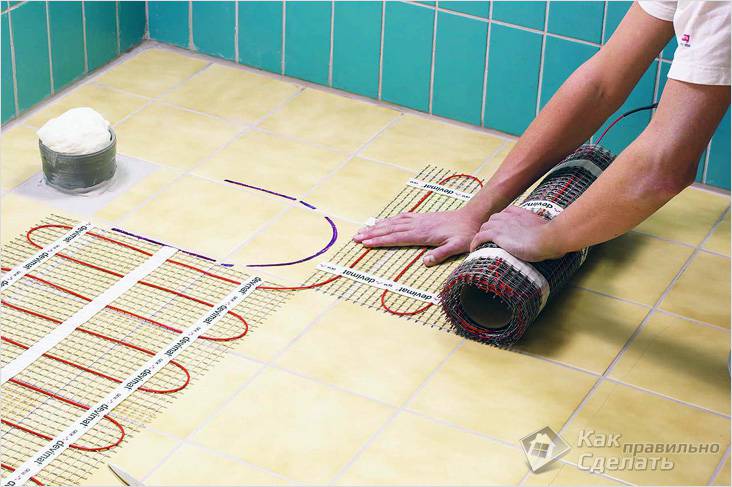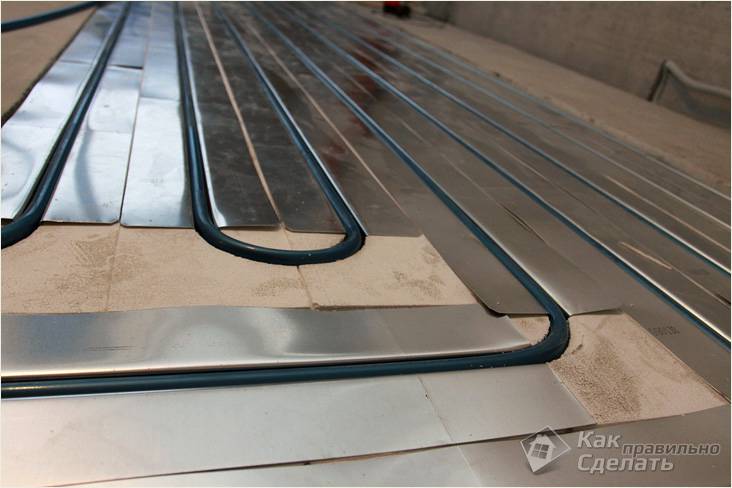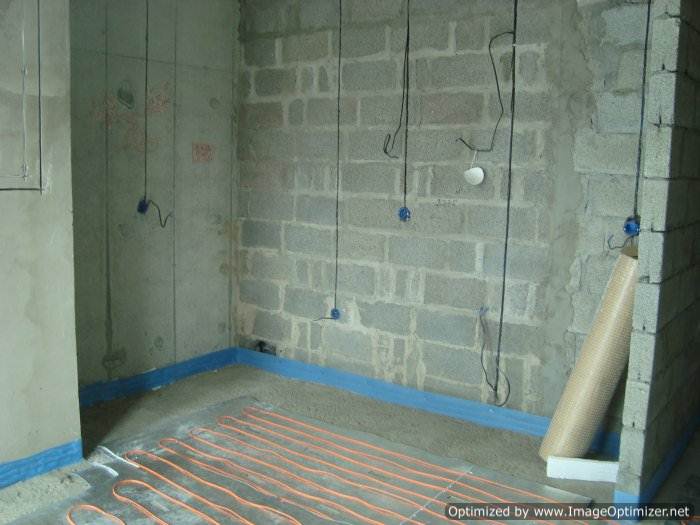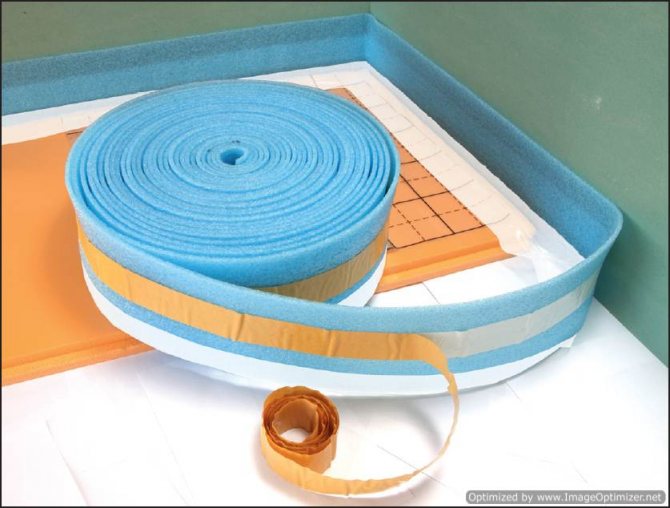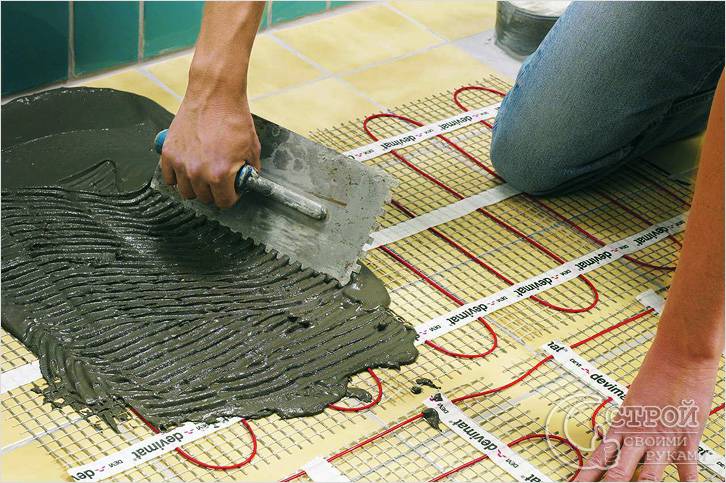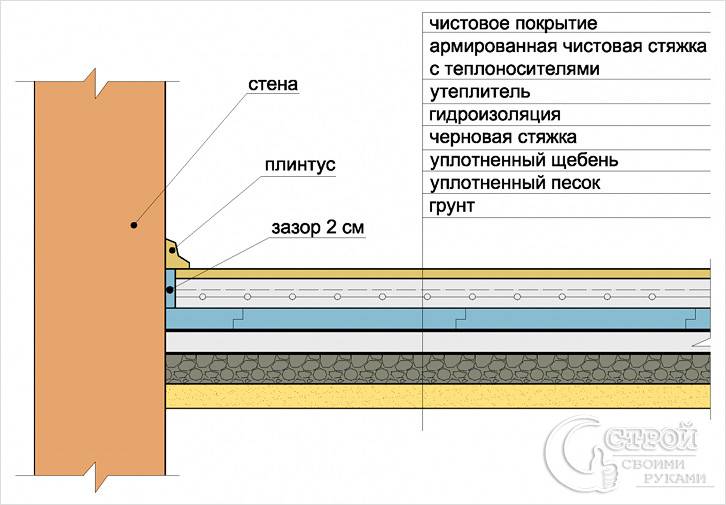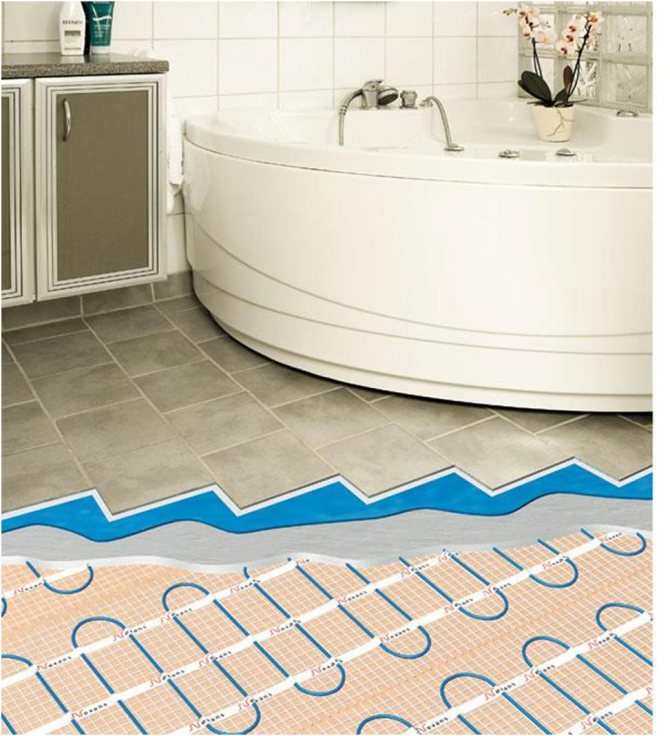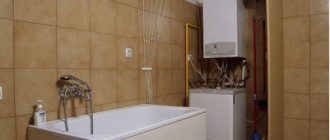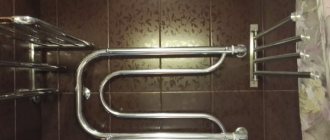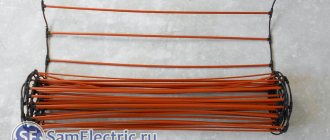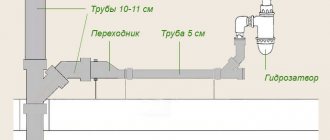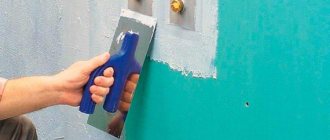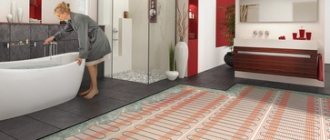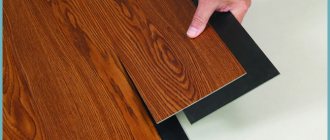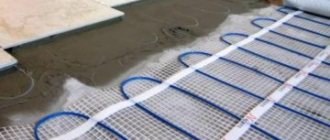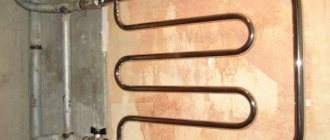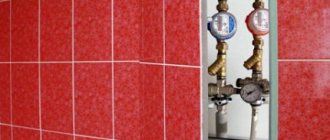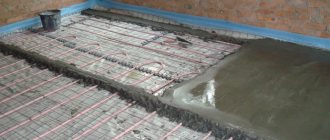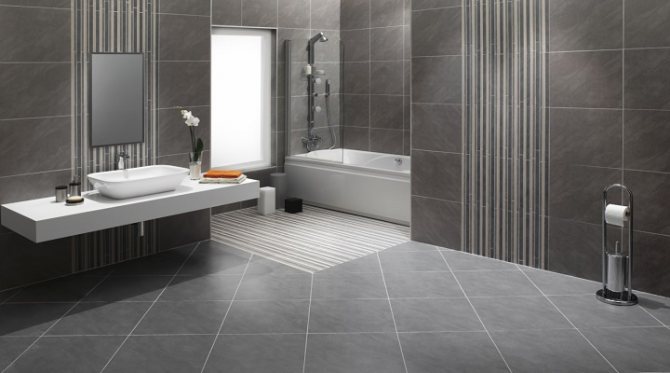
Floor insulation - this is a necessity that arises for residents of apartment buildings, especially those living on the ground floor, where the cold enters the apartment through the basement.
As a rule, floors in multi-storey buildings are made of reinforced concrete structures that have low thermal insulation properties, so they need insulation to achieve comfortable living conditions and save on heating an apartment.
How to insulate a bathroom floor?
When insulating a floor, the first step is to build a waterproofing layer that will protect the base of the floor from water and moisture. For this, a polyethylene film laid in two layers is perfect.
Next, you can proceed to the selection of thermal insulation material. Fortunately, the modern market offers the consumer a variety of roll materials that form an excellent thermal insulation coating, which also acts as an excellent sound insulator.
If your apartment is on the ground floor, then the first step is to take care of its insulation - all interpanel joints and other openings must be sealed with polyurethane foam. The floor, as a rule, is insulated with the help of the construction of a cobbled sheathing, between the bars of which a heat-insulating material is installed.
The most popular material for floor insulation is mineral wool, which, in addition to excellent thermal insulation properties, is an affordable, environmentally friendly and durable material.
The floor structure when applied is as follows: waterproofing, then a crate made of wood, between which cotton wool, chipboard or fiberboard sheets are installed to level the surface and the finishing floor covering (laminate, carpet, linoleum or another type).
The quality of work is determined by heat loss and heating costs. With thermal insulation, special attention must be paid to the quality of the materials used for repairs, since products of dubious quality only in very rare cases provide the proper level of thermal insulation.
Recently, the insulation of loggias and the creation of small living rooms from them has been gaining popularity. Also, many have attached a loggia to the room, removing the window block. Someone equips a workplace with a computer desk. And everyone is faced with the problem of how to insulate the floor.
The first advice, if it is possible to take the battery to the loggia, do it. In this case, you will significantly reduce the energy consumption of the warm floor.
Choice of flooring - tiles, laminate or carpet will also affect the performance of the system. For example, tiles have high thermal conductivity and therefore will give more heat to the air, and laminate and carpet will heat up faster, spend less electricity, but the air will warm up less.
Correct thermal insulation will also reduce floor heating time and save energy.... We recommend that you first insulate the walls of the loggia and only then the floor, since you need to reliably insulate the perimeter of the heated floor so that the heat does not go out into the street from it. Most often, the walls are insulated with 10 cm foam, which is covered with drywall. We recommend laying compacted (extruded) foam on the floor.
If you are planning a laminate, then lay plywood on this foam, for rigidity and fix it. Next, instead of the standard laminate backing, a 3mm reflective metallized backing is installed.
On it infrared thermal film and laminate.If tiles are planned, then a metal (masonry) mesh is laid on this foam, a heating cable is poured onto it and a screed 3-5 cm is poured. further tile. Or, first, a metal mesh, a screed, and then a thin cable, which is located in a layer of tile adhesive.
Laying cables or mats on loggias without thermal insulation is strongly discouraged. The power of the cable for a cold room must be at least 200 W / m2, i.e. for 4 m2 cable power not less than 800W .
How to deal with the feeling of cold
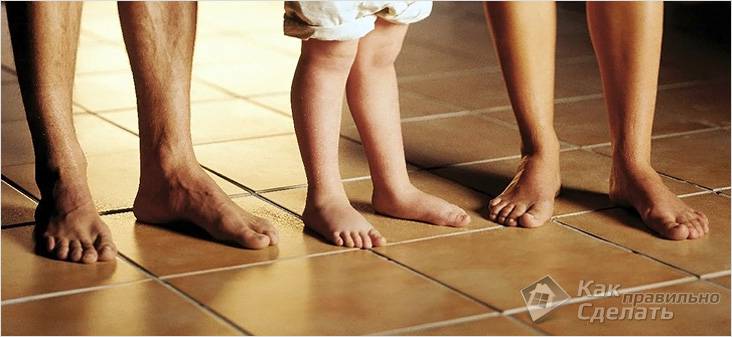

If the floor is cold
Since it is customary to lay the floor in bathrooms with tiles, it can become warm only in one case - if you heat it from below with something. The fact is that the tile itself is a cold material, standing on which with bare feet you will experience a certain discomfort, as if ceramic tiles are drawing heat out of you. Therefore, even if you are used to walking barefoot around the house all year round, being on the “bare” bathroom floor will not be very pleasant for you.
Thermal insulation of a wooden floor
When building a house, as a rule, all work on its insulation, including the floor, is carried out at the initial stage. However, what to do if a ready-made construction option is purchased, requiring work on its insulation?
Experts in this field say with confidence that this is not such a difficult job. Even a beginner can do it. One has only to thoroughly figure out which material to use to preserve heat and by what method.
The main rule when choosing a material is reliability and high level of thermal insulation properties... Most often, for this process, they choose: sheets of foam, mineral or stone wool, ecowool, cork insulation or foamed polyethylene.
Consider some of the nuances that arise when choosing such heaters:
- compare your financial capabilities with respect to the cost of the selected insulation (for greater awareness, it is important to know that each of the above examples has good thermal insulation, so advertising arguments will be superfluous);
- it is strongly recommended to use mineral or ecowool when small rodents are present in your house (mice are the most frequent tenants in the spaces between the foundation base and the wooden flooring);
- if you are looking for an economically viable option, then stop at expanded clay. Talk about its harmfulness and toxicity turned out to be untenable.
So, the required material has been selected. The stage of preparatory work begins. This includes dismantling the old skirting board and, directly, lifting the wooden floorboards themselves. It is very important, when removing floorboards, be sure to leave its own serial number on each, this will allow you to simplify the reverse process for restoring the coating.
The next step for you is to inspect each log for the presence of rot, fungus or mold. If any of them have severe wear or damage, replace with a new one, and if this is not possible, treat with a protective solution. Next, you need to clean the base under the log - sweep or use a vacuum cleaner. The planned work is almost half done, now it is necessary to lay the insulation.
In the order of the first stage, a heat-insulating material is laid, that is, sheets of stone or mineral wool, which is placed in the space between the logs. The principle of using expanded clay instead of cotton wool is the same, pour it at least 10 cm thick.
Its thermal insulation layer now you should definitely cover it with a layer of vapor barrier (for example, a polyethylene film). This material is laid with an overlap, while each of the strips overlaps the previous one by at least 15 cm. In fact, the process of floor insulation is completed.It remains to return each floorboard to its place, according to the numbering, and put the plinth.
Insulation of the floor in the bathroom
Inhabitants of panel dwellings still of the Soviet structure are waiting for the arrival of winter with bated breath. The point is not even that they like this time of year so much, here, rather, the point is the opposite. And there is a reason not to love winter for residents of similar houses.
If in summer, with extreme heat, cracks and holes in the walls serve as salvation from the hot air inside the living space, then with the arrival of frost, the same saving gaps turn out to be almost fatal for the well-being of the owners. Since not many people want to live continuously in a cool apartment (since the heating is completely different from what it was before), there is only one way out to insulate.
Virtually everything can be insulated. The most obvious solutions are window insulation (or replacing wooden with plastic) and insulating the front door (or replacing it with a front door-safe). From unobvious insulation of walls and floors. Since the overhaul should be started specifically with floor insulation, it will be the main victim of the article provided.
So, floor insulation. To begin with, you should make your choice with materials. There are probably a number of modes of action to carry out the work provided. The following option is quite well-known among the representatives of the most adult generation: we open the floor, lay insulation, cover the floor.
The room in which work will be carried out is freed from furniture and other things that can interfere with work. Then the boards, which are the floor itself, are gently lifted. He works carefully so as not to destroy them, because these same planks will be introduced back. Then one or a number of layers of insulation are laid.
It is important to pay attention to the fact that the recognizable insulation "Styrofoam»In the given case will not become desirable. Its main problem is that the rodents that are found in old dwellings (and in the bulk of old houses they are), take this product of the chemical branch into small balls. And as it turned out, polystyrene in their nests, warming not people, but a brood of rats or mice.
Therefore, it is better to focus on more innovative materials. After the insulation is laid, it is allowed to overlap the floor. It makes sense to strengthen the wood with each other with screws, since they are the most correct in use. Plus, fastening with screws (or self-tapping screws) will avoid floorboards squeaking for many years.
The last thing that remains is to lay linoleum (or other floor covering) on top of the already insulated floor and rejoice at the result of the creation of your own hands.
Installation
Theoretically, you can insulate the bathroom floor with your own hands, using detailed instructions. Let's look at this process in general terms:
- First, the surface to be worked on is leveled.
- Then a waterproofing layer is spread on it.
- Then a damper tape is used, which is stretched along the perimeter of the room.
- Material with cells for future pipes is laid on top. The same material also plays the role of an insulator at the same time, which does not allow heat to go down.
- Then the mesh is laid and a cement screed is formed on top.
The most important and responsible task in this case is to properly lay the pipes. In order not to be mistaken in this matter, you need to level the coating plate, use polyethylene and expanded polystyrene. On top of all this, you should expand the reinforcing mesh, and then lay a flexible pipe for underfloor heating. It should be placed only in those areas of the room where heating is really necessary for you (under the bath or shower stall, a warm floor is not needed). Then you need to connect the pipe to the collector, not forgetting about the protective corners.Be sure to check the tightness of a freshly installed system. After that, you can pour the screed and lay the tiles.
As you can see, floor insulation in the bathroom is not a luxury at all, but just a convenient and practical solution, for which you will definitely thank yourself when the cold season comes.
Features of internal wall insulation in the bathroom
In addition to the fact that internal insulation is always less preferable than external insulation, in the case of a bathroom there is another difficulty - a high moisture index. Therefore, the material used for this should not be afraid of moisture and not be saturated with it, reducing its performance characteristics.
Important! Often it is necessary to insulate not only the walls, but also the ceiling, since large heat losses also occur through it.
In addition to this, you must also keep in mind the following:
- When insulating the walls in the bathroom, the vapor permeability indicator is often violated, so a good ventilation system should be installed in the room;
- Walls before finishing with insulation should be treated with antifungal impregnations. It does not matter whether we are talking about a wooden wall structure, or about brick or concrete - the risk of mold formation is equally high;
- The formation of cold bridges should not be allowed, so be careful about the absence of gaps between the insulation plates;
- To prevent moisture from affecting the insulation, it is necessary to use a hydro-barrier.
Types of thermal insulators
High-quality thermal insulation in the bathroom is a guarantee of a comfortable microclimate. You can minimize heat loss through the floor and walls. The choice of insulation must be done competently. Preliminary work on the insulation of the bathroom requires the removal of the old finish. The structure is treated with water-repellent mixtures that protect materials from microorganisms. In advance, you need to take care of eliminating distortions and drops.
Mineral wool mats
This material includes mineral fibers in its structure. Due to this, the thermal insulation layer “breathes”. Therefore, you do not have to deal with the appearance of condensation on the walls and ceiling. Masters are advised to give preference to this building material if money is to be invested in high-quality hydro-, vapor barrier.
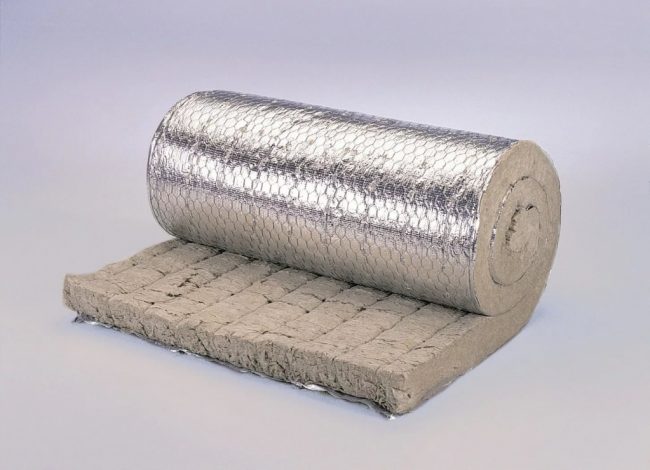

When performing thermal insulation work, it is necessary to avoid violating the integrity of the waterproofing layers, because insufficient tightness will lead to the absorption of moisture by the insulation. This will violate the thermal insulation characteristics of the building material. Plates made of this material are characterized by increased rigidity. It is necessary to follow the technology of fastening between the guides of the frame, which will prevent the insulation from sliding in the vertical direction.
For the supporting frame, galvanized metal profiles are used. It is not recommended to use wooden slats, as this material is capable of absorbing moisture. The period of its operation is much shorter when compared with metal. After a certain period, they can deform, which will affect the integrity of the structure.
Foam work
The foam has high moisture-repellent and thermal insulation characteristics. Therefore, it is often used as a heater. But it is not characterized by vapor permeability, which will not allow the walls to "breathe", therefore, will lead to the accumulation of condensate. After a while, this can be the cause of the destruction of the walls, the appearance of mold. The installation process when working with foam is not difficult, you can handle it yourself.
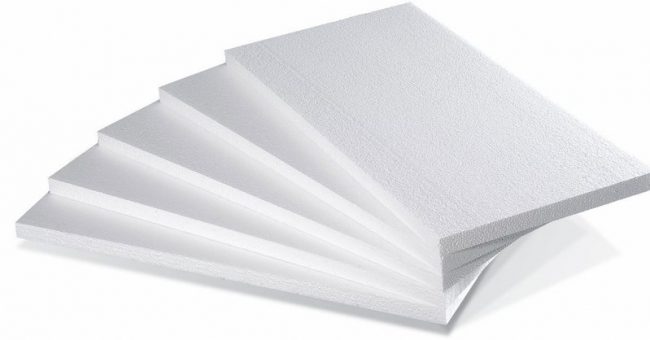

Cork insulation
The use of such a material involves processing it with a special impregnation based on wax, which will increase the moisture-repellent properties. The technology of working with cork insulation is not complicated. It is glued like wallpaper. This requires the use of special glue. The exotic material is distinguished by its high price, since it is made from the bark of cork oak.
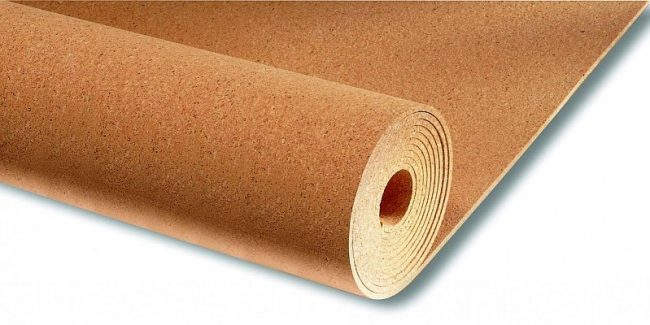

Polyurethane foam
It is a liquid heat insulator. It is characterized by high strength and fire resistance. It has good heat and sound insulation characteristics, light weight, which eliminates additional stress on the walls. Polyurethane foam adheres well to other materials, so it can be directly applied to the insulated surface. Its structure allows air to circulate freely.
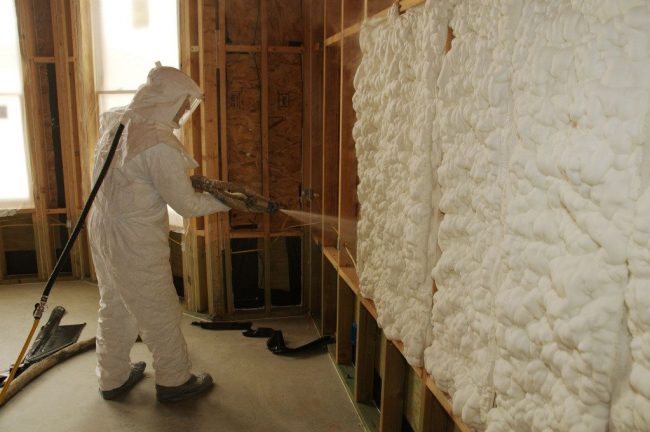

It is not necessary to additionally provide for the laying of a hydro-, vapor barrier film. Thanks to its biological and chemical properties, it prevents the appearance of mold. Since the material is applied by spraying, it is convenient to work with it in any premises. At the same time, a small thickness of the thermal insulation layer is required, which maximizes the useful space in the bathroom.
It will be interesting: Smart meters themselves can transmit water readings
"Warm" plastering compounds
When insulating walls, it is more correct to finish them with a plaster compound, which has a small coefficient of thermal conductivity. The cement base and certain additives make such formulations vapor permeable. Based on the fillers, they can be represented by vermiculite, sawdust and expanded polystyrene compositions.
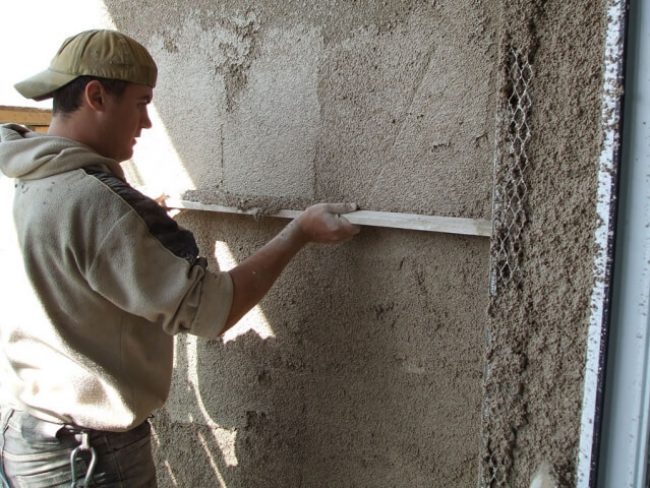

The advantages of warm plasters are considered to be the need for preliminary leveling of the surface. If you apply the composition, then the surface is flat. They are characterized by excellent adhesion. The disadvantage of these compositions is that they are applied in a thick layer, which affects a decrease in the usable area of the room. Additional finishing required. When applying warm plastering compounds, the surface is pre-treated with a primer.
What materials to use
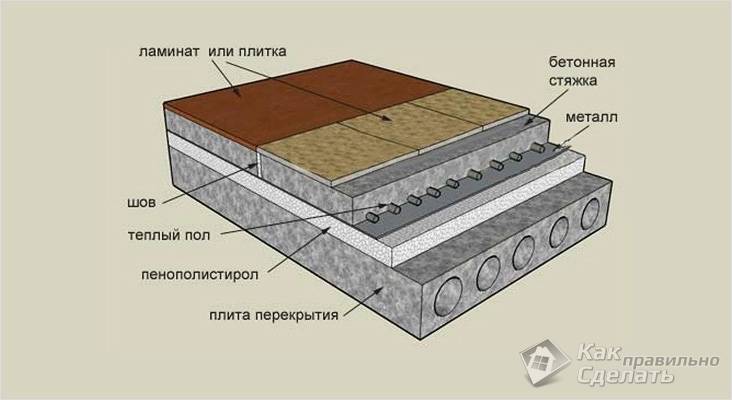

Approximate insulation scheme
In addition to the fact that the tile will not give you a warm sensation, its temperature (below room level) can be reduced by the presence of colder materials under it (if the floor of the house floor rests directly on the ground) or unheated rooms (such as a basement).
In these cases, you should take care of additional floor insulation. And since it is necessary to insulate the floor in the bathroom in such a way that its waterproofing property does not suffer, then the material must be chosen for this hard, not deforming under the weight of a person, furniture and flooring. Extruded polystyrene foam is best suited for these purposes. It has a low density, but at the same time it is a slab material that can be used for floor insulation. It should be laid on a vapor barrier to prevent unnecessary moisture from entering the ground or from the thickness of the floor.
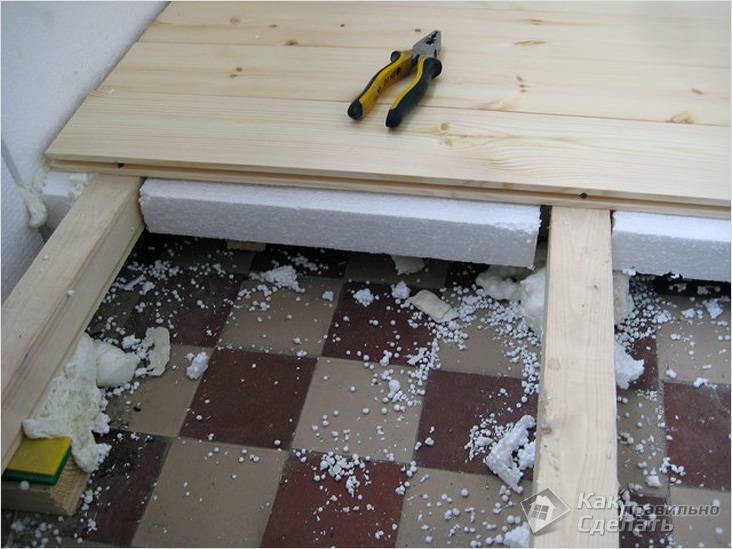

Floor insulation with expanded polystyrene
On top of the expanded polystyrene, it is imperative to fill in a cement-sand screed with a thickness of at least 5-6 centimeters. In this case, the screed must be reinforced with a metal mesh in order to obtain a monolithic structure. But there is no great need to put a waterproofing film between the extruded polystyrene foam and the screed, since this type of insulation does not absorb water into itself and does not swell, and the ceramic tile, which will lie on top of the entire structure, does not pass water through itself at all (with the exception of the seams) ...
General requirements
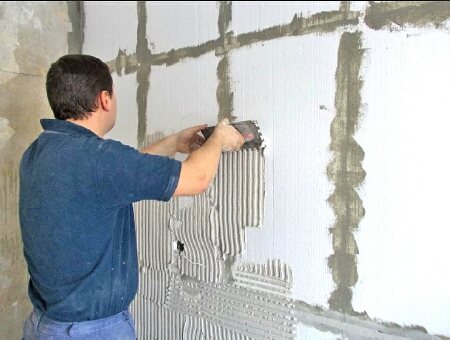

In some cases, the insulation of the bathroom can be done without any additional funds. It is enough to install a new heated towel rail and check the ventilation system, if necessary, install a fan in it.
If these measures turn out to be ineffective, then the walls of the bathroom are trimmed with insulation. When working, consider the following:
- The thermal insulation material must adhere tightly to the wall, the formation of voids is not allowed.
- Before installing the insulation, the wall is thoroughly dried and treated with an anti-fungal compound.
- The seams between the insulation (when using expanded polystyrene) are sealed with a sealant, the seams between the finishing material also need waterproofing.
- When choosing a material, it is necessary to evaluate its performance characteristics, in particular the ability to maintain its shape throughout its entire service life.
- When using dowels, so-called "cold bridges" are obtained, which need thermal insulation with mastic or waterproof putty.
Particular attention is paid to ventilation. If the exhaust system does not cope with its task, you should create a forced ventilation system that will ensure a high-quality outflow of moist air from the room.
Want to order a bathroom renovation? Refer to the website https://stroy-25.ru/remont_vannoy_komnati_i_sanuzla/
Thermal insulation of the floor with mineral wool
Mineral wool is one of the most common and quite effective insulation materials. The material can withstand sufficient mechanical stress, is resistant to fire and has excellent thermal insulation properties. However, for a bathroom, mineral wool is not the best option for insulation due to its increased hygroscopicity, or, more simply, its increased ability to absorb moisture, which as a result can lead to an undesirable increase in humidity and the formation of various fungi.
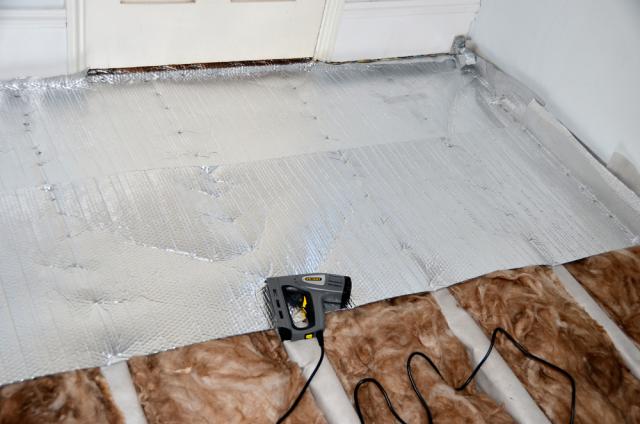

If, nevertheless, you decide to use mineral wool as a heater for the bathroom, you should make sure that waterproofing work is carried out along with the insulation, and at the highest level.

